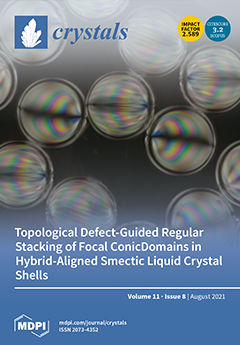Two new complexes, [Cu(dimpyr)
2(H
2O)
2](NO
3)
2.2H
2O (
1) and (Hamdimpy)
2[CoCl
4].H
2O (
2), with the monodentate ligand 2-amino-6-methylpyrimidin-4-(1
H)-one (dimpyr) and the countercation 4-amino-2,6-dimetylpyrimidium (Hamdimpy),
[...] Read more.
Two new complexes, [Cu(dimpyr)
2(H
2O)
2](NO
3)
2.2H
2O (
1) and (Hamdimpy)
2[CoCl
4].H
2O (
2), with the monodentate ligand 2-amino-6-methylpyrimidin-4-(1
H)-one (dimpyr) and the countercation 4-amino-2,6-dimetylpyrimidium (Hamdimpy), respectively, were prepared and characterized by single crystal X-ray diffraction, elemental analysis and IR spectroscopy. In (
1), the Cu(II) cation is tetracoordinated, in a square plan fashion, by two nitrogen atoms from the pyrimidine ring of the organic ligand and two oxygen atoms of two coordinated water molecules. In the atomic arrangement, the CuO
2N
2 square planes are interconnected via the formation of O-H…O hydrogen bonds involving both coordinated and free water molecules and NO
3− nitrate anions to form inorganic layers parallel to the (a, b) plane at z = (2n + 1)/4. In (
2), the central atom Co(II) is four-coordinated in a distorted tetrahedral fashion by four Cl
− ions. The [CoCl
4]
2− tetrahedra are arranged parallel to the plane (
10) at x = (2n + 1)/2 and the organic cations are grafted between them by establishing with them hydrogen bonds of CH…Cl and NH…Cl types. The vibrational absorption bands were identified by infrared and Raman spectroscopy. Intermolecular interactions were investigated via Hirshfeld surfaces and electronic properties such as HOMO and LUMO energies were derived. The two compounds were characterized by thermal analysis to determine their thermal behavior with respect to temperature.
Full article





